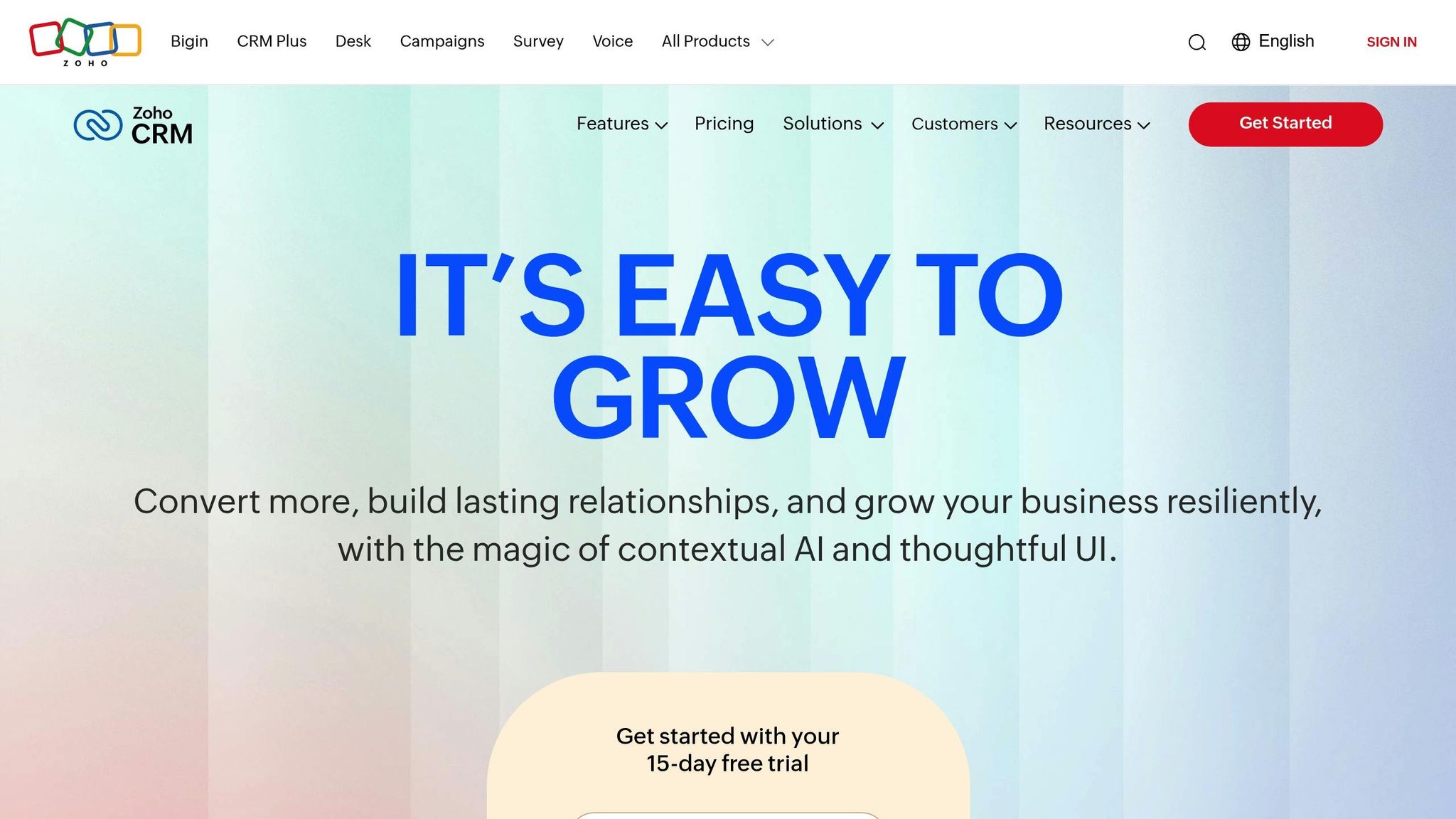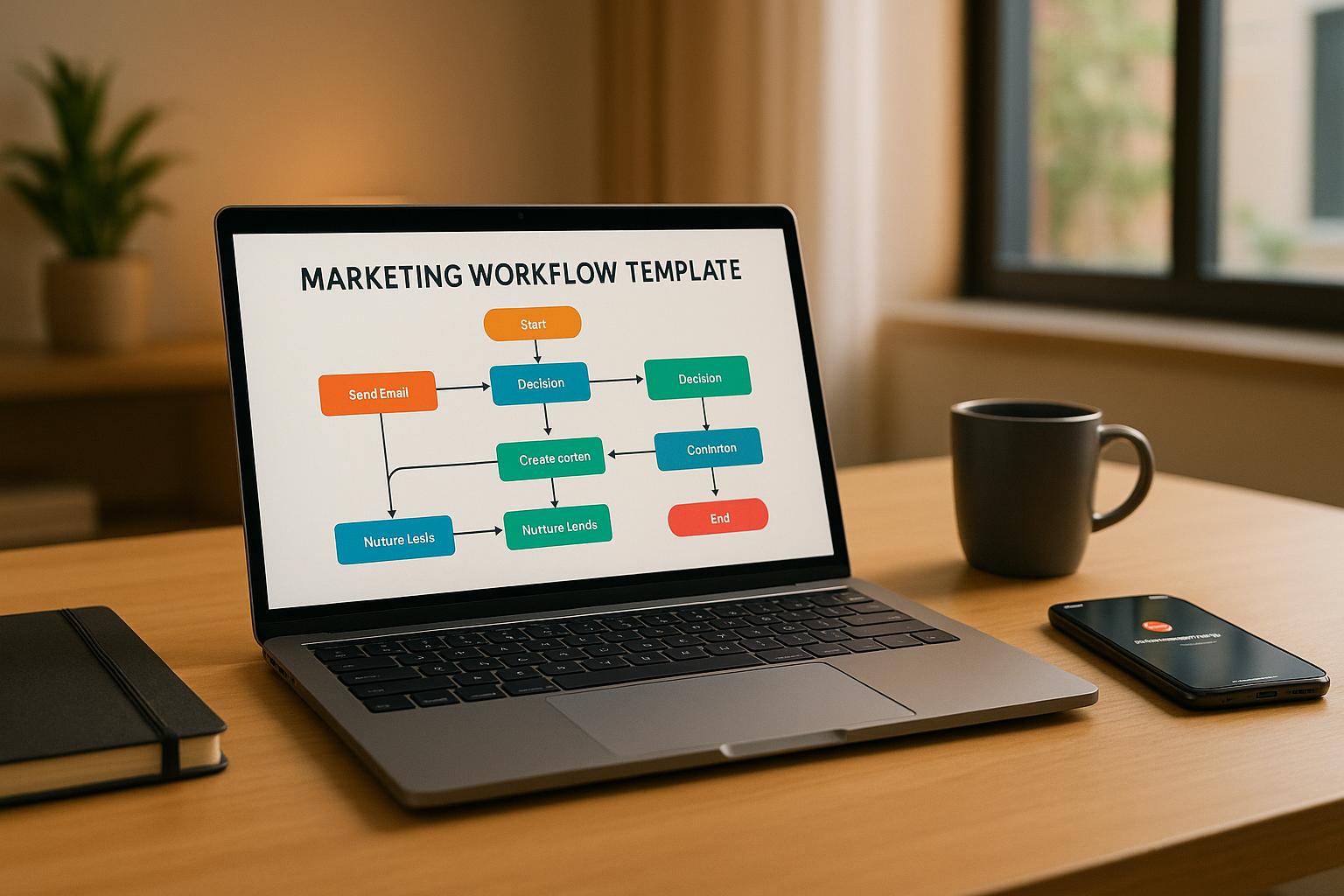Want to save time, close more deals, and reduce errors in real estate marketing? Marketing automation with workflow templates can help. Here’s why it works:
- Time-Saving: Automates repetitive tasks like follow-ups and scheduling, freeing up hours for client interactions.
- Better Lead Management: Tracks and prioritizes leads using real-time data, ensuring no opportunities are missed.
- Consistency: Ensures timely, personalized communication without requiring manual effort.
- Scalability: Handles larger workloads without needing extra staff, making it ideal for growing businesses.
- Cost-Effective: Reduces operational costs by minimizing manual tasks and errors.
- Improved Client Experience: Faster responses and tailored outreach lead to happier clients.
Quick Comparison
| Aspect | With Automation & Templates | Manual Process |
|---|---|---|
| Daily Tasks | Automated execution | Handled individually |
| Time Management | More time for clients | Hours lost to admin work |
| Follow-up Consistency | Systematic and timely engagement | Sporadic and inconsistent |
| Error Rate | Low | High |
| Scalability | Easily handles growth | Requires more staff |
Switching to automation not only saves time but also boosts productivity and ensures consistent results. Dive into the article to learn how these tools can transform your real estate marketing.
Time-Saving Automation Systems and Workflows for Real Estate Using Zoho CRM

1. Workflow Template Automation
Workflow template automation is changing the game in real estate marketing by streamlining repetitive tasks into efficient, repeatable processes. According to Salesforce, over 90% of workers experienced higher productivity with automation tools, and nearly the same percentage reported quicker decision-making and fewer errors.
These templates can juggle multiple marketing tasks simultaneously. For example, when a potential buyer shows interest in a property, the system can send a tailored welcome email, update CRM records, schedule follow-ups, monitor engagement, and share relevant property listings – all automatically. Let’s break down the benefits:
Enhanced Lead Management
Automated workflows ensure no lead is overlooked by tracking interactions across platforms like websites, emails, and property searches. This approach uses real-time data to help agents focus on leads that show the most promise.
Improved Time Efficiency
Routine tasks often eat up valuable time. Automation takes care of these, freeing agents to concentrate on building relationships and closing deals. It keeps communication consistent without the need for manual effort.
Personalization at Scale
With workflow templates, personalization becomes effortless. The system adjusts outreach based on a prospect’s behavior and preferences. For instance, if someone frequently browses luxury condos in a specific area, the system will prioritize sending them similar listings.
Cost-Effective Operations
While there may be upfront costs, the long-term savings are undeniable. Automation reduces the need for extra staff as the business grows, minimizes mistakes in communication, and ensures consistent branding across all channels.
Scalability and Compliance
As real estate businesses expand, workflow templates make it easy to scale without piling on administrative work. Successful marketing strategies can be replicated for different property types or markets with minor tweaks. Plus, automated systems can include essential legal disclaimers and fair housing statements, ensuring compliance every step of the way.
2. Manual Marketing Methods
While automated workflows have reshaped real estate marketing, traditional manual methods still present significant hurdles. These outdated approaches often lack the efficiency and reliability offered by automation, creating bottlenecks that can slow growth and productivity.
Time-Intensive Operations
Manual marketing requires agents to handle tasks like updating listings and sending follow-ups by hand. This process eats up valuable hours that could be better spent on activities like meeting clients or showing properties.
Lead Management Challenges
Tracking and managing leads manually – often through spreadsheets or physical files – introduces inefficiencies and inconsistencies. These issues can have tangible effects, such as:
| Lead Management Issue | Impact on Business |
|---|---|
| Delayed Responses | Lower lead conversion rates (up to 20% loss) |
| Missed Follow-ups | Higher lead drop-off rates |
| Data Entry Errors | Strains client relationships |
| Incomplete Records | Hinders effective lead nurturing |
Resource-Heavy Costs
Manual methods often come with a hefty price tag. Tasks like printing brochures, organizing open houses, and maintaining paper-based systems require significant labor and materials. These costs can spiral as business scales, especially if more staff is needed to keep up with demand.
Limited Scalability
As a real estate agency grows, the inefficiencies of manual processes become even more apparent. Scaling up requires more resources and personnel, creating obstacles that can stifle expansion and hurt overall performance.
Quality Control Issues
Human error is an unavoidable part of manual processes. Without standardized templates or automated checks, it’s difficult to maintain consistency in branding and communication across listings and client interactions.
Impact on Client Experience
The inefficiencies of manual marketing directly affect clients. Delayed responses, inconsistent communication, and a lack of personalization can leave buyers and sellers feeling frustrated – especially in today’s fast-moving market.
sbb-itb-2f9da9d
Key Differences Between Automated and Manual Methods
When comparing automated workflows to manual methods, the differences in productivity, precision, and overall business outcomes in real estate are striking. These approaches shape the way professionals manage their time, handle tasks, and deliver results.
Performance Metrics
Automated workflows can save real estate professionals more than 2 hours each day on administrative tasks. That adds up to roughly 25 hours a week – time that can be reinvested in activities like meeting with clients or showcasing properties. These savings highlight the transformative potential of automation in daily operations.
Operational Impact
The table below highlights the operational distinctions between automated systems and manual methods:
| Aspect | Automated Workflow Templates | Manual Methods |
|---|---|---|
| Response Time | Immediate lead follow-up, 24/7 availability | Limited to standard business hours |
| Accuracy | Minimizes errors with precise processes | Prone to human error and inconsistencies |
| Scalability | Handles larger workloads without extra staff | Requires more staff as workload increases |
| Cost Efficiency | Boosts sales productivity by 14.5% | Higher costs as operations expand |
| Lead Management | Tracks and nurtures leads automatically | Manual tracking, increasing risk of oversights |
| Brand Consistency | Ensures uniform messaging across channels | Messaging can vary depending on individual handling |
By automating repetitive tasks and centralizing data, real estate professionals can improve time management, reduce errors, and focus on building stronger client relationships.
Technology Integration
Modern automation platforms are designed to integrate effortlessly with existing real estate tools, creating a cohesive system for managing operations. These platforms offer features like real-time lead scoring, automated property matching based on client preferences, intelligent scheduling for showings, and detailed performance analytics. Such integration not only simplifies workflows but also ensures agents have the tools they need to deliver exceptional service.
Financial Impact
The financial benefits of automation are hard to ignore. With the global workflow automation market expected to hit $264.69 billion by 2026, growing at an annual rate of 12.51%, it’s clear that automation is becoming a cornerstone in real estate marketing strategies. These tools help businesses cut costs while increasing efficiency and output.
Client Experience Enhancement
Automation also elevates the client experience. By ensuring consistent communication and offering personalized services, automated workflows can lead to higher satisfaction levels among clients, strengthening trust and loyalty in the process. This focus on the client’s journey sets automated methods apart from traditional approaches.
Conclusion
Workflow automation tools are transforming the way real estate professionals handle their day-to-day tasks and connect with clients. On average, agents using these templates close two more deals each year compared to those sticking to manual methods.
Beyond boosting deal flow, automation simplifies operations – over 90% of professionals report increased productivity. This means quicker response times, consistent branding, and an improved experience for clients.
To make the most of automation, here are some practical steps:
- Focus on lead nurturing and timely follow-ups
- Use automated property suggestions tailored to client search habits
- Create consistent communication plans for staying in touch with past clients
- Track and analyze key metrics to fine-tune your approach
The future of real estate marketing is rooted in smart automation. With tools like these, professionals can sharpen their competitive edge and achieve long-term growth. Growth-Realty offers AI-driven marketing solutions to help streamline your operations and amplify your results.
FAQs
How do workflow templates improve lead management in real estate marketing automation?
Workflow templates take the hassle out of lead management by automating repetitive tasks like capturing new leads, sending follow-ups, and nurturing prospects. This ensures every potential client is accounted for without anything slipping through the cracks. By using predefined actions triggered by events – like a new inquiry or an email being opened – real estate professionals can respond promptly and consistently. The result? More time saved and smoother operations.
What’s more, automation through workflow templates makes segmentation and personalization much easier. For instance, leads can be grouped based on where they are in the buying process. This allows you to send tailored messages that align with their specific needs, increasing engagement and improving the chances of turning leads into clients. It’s a smart way to stay ahead in the competitive real estate market.
What are the upfront costs of marketing automation, and how do they compare to the long-term savings?
The upfront costs of setting up marketing automation can differ based on the platform you choose, the tools you need, and how much customization is involved. These expenses typically include software subscriptions, onboarding fees, and team training. While the initial price tag might feel steep, the long-term benefits can far outweigh it.
Automating tasks like email campaigns, lead nurturing, and social media scheduling helps businesses save time, minimize manual errors, and concentrate on more strategic activities. Over time, this improved efficiency not only cuts costs but also boosts ROI, making marketing automation a smart move for real estate professionals aiming for growth.
How can workflow templates be tailored to meet real estate regulations and enhance the client experience?
Workflow templates can be adjusted to meet real estate regulations by incorporating key compliance measures. These might include steps like mandatory document verification, legal disclosures, and ensuring adherence to fair housing laws. Doing so helps ensure that every part of the process aligns with industry standards, lowering the chances of mistakes or regulatory issues.
On top of that, customizing workflows to feature personalized communication, automated follow-ups, and efficient document sharing can greatly enhance the client experience. By automating repetitive tasks and maintaining consistency, real estate professionals can dedicate more time to building relationships and closing deals, while clients benefit from a smoother and more transparent process.



